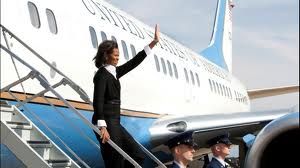FLOTUS' Flight Had to Abort Landing
A White House plane carrying Michelle Obama came dangerously close to a 200-ton military cargo jet and had to abort its landing at Joint Base Andrews on Monday as the result of an air traffic controller’s mistake, according to federal officials familiar with the incident.
Ultimately controllers at Andrews feared the cargo jet would not clear the runway in time, said the officials, who spoke on condition of anonymity because they are not authorized to speak for their agencies.
FAA officials confirmed that the first lady was aboard the plane but had no additional immediate comment. They expected to release a statement later Tuesday. The first lady’s office also had no immediate comment.
The Federal Aviation Administration, already dealing with a series of controversies involving controllers sleeping and watching a movie on the job, sent a team of investigators Tuesday to the Warrenton radar control center, where the mistake was made.
The first lady was returning from a television appearance and other events with Jill Biden in New York and was aboard a Boeing 737 that is part of the presidential fleet of jets when the error occurred on final approach to Andrews.
The controllers in the tower at Andrews recognized that the massive C-17 and the Obama flight, designated EXEC1F, a classification for a plane carrying members of the president’s family, were far too close when the Warrenton controller handed off responsibility for the two aircraft.
They ordered the Obama plane to execute a series of S-turns in an effort to create a safe distance between it and the C-17, federal officials said. When those maneuvers failed to achieve the required distance between the two planes — and the Andrews controllers realized the cargo jet would not have time to get off the runway before the presidential plane arrived — they aborted landing of the Obama plane and ordered it to circle the airport.
Because an airplane’s wake causes severe turbulence and, in extreme cases, can cause a plane that enters it to crash, the FAA has strict standards on how much distance controllers should maintain between planes.
A fully loaded C-17 can create such turbulence that the FAA requires a five-mile separation behind it. The presidential fleet 737 already was far closer than that when the handoff took place from the Potomac Terminal Radar Approach Control (TRACON) facility in Warrenton.
“The manager and tower controller at Andrews did several things to try to increase the separation on final [approach] before ordering a go-around,” said a senior FAA manager familiar with the incident.
The FAA manager said the TRACON controller exhibited “really bad controller technique.”
“Not only did he get them too close, he told the [Andrews controller] that they were farther apart than they were,” he said.


